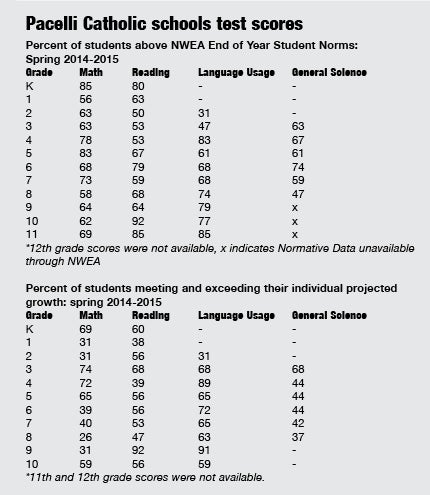Pacelli students above average in NWEA MAP tests
Published 11:02 am Friday, August 14, 2015
On average, Pacelli Catholic Schools students tested at or above average on the yearly North West Education Association Measures of Academic Progress, or NWEA MAP, test for the 2014-15 school year.
Now, Pacelli is continuing to use those test scores as a guide for student improvement.
The tests align with the Minnesota state standards, the Common Core state standards and the National Science standards.
But the scores are only part of process for Pacelli, which tests students multiple times a year to track individual progress.
“It also helps our teachers plan their instruction according to what their kids need,” Principal Laura Marreel said.
Pacelli tests students grades K-12 three times a year, with students from kindergarten through second grade testing in math and reading, and students from third grade through 12th grade testing in math, reading, science and language skills.
“A lot of schools in our diocese use this test to measure their growth, and I think, understanding that all kids are different, and they come from different backgrounds, different priorities at home, different education levels, we really value individual growth,” Marreel said. “So that’s what we strive to see with each of the tests we give kids.”
The students get their test scores right after the test is finished, and from that Marreel said students can make a plan for the next two tests. They work with teachers and counselors to set goals for the next test.
“We really focus on that growth each year,” Marreel said.
The tests are not the same among each student, as the questions adjust while the students take the test depending on their answer.
According to test scores provided by Marreel, more than 50 percent of students in each grade K-11 tested at or above average in the math and reading RIT Scale Norm. Scores for 12th grade were unavailable. In math, the lowest score was in first grade at 56 percent at or above average, and the highest was in kindergarten at 85 percent, with fifth grade in close second at 83 percent. In reading, test scores ranged from 50 percent at or above average in second grade to 92 percent in 10th grade.
Marreel compared the national mean scores for the spring 2015 testing window to Pacelli’s students’ mean scores from the same grade levels for the spring 2015 tests.
The data shows 53 percent of students who fell below the average score don’t have English as a first language, and 89 percent of students below average transferred to Pacelli from another school.
Each Pacelli class has around 20 students on average, which means one student’s score could make a big difference in the average score for that grade. Marreel said the main goal is that students will reach the 75th percentile or above. She said one thing that helps students achieve that is the student-teacher relationships, as well as the parent-teacher relationships.
“I think when we think about our kids as individuals here, and take into consideration their individual needs and their individual growth plans, I think those are key to helping each one improve,” she said. “And that’s really our driving force is their individual growth.”
Marreel said Pacelli’s students’ scores are above last year’s scores, which she guessed was due to the way administration analyzes the scores and makes decisions about programming and staffing needs based on those scores throughout the year. This year, the school added a staff member in reading and the after-school academy they have for help with homework, which Marreel said helped students.






